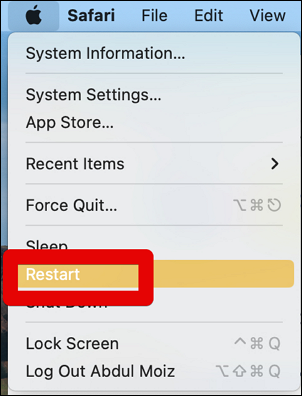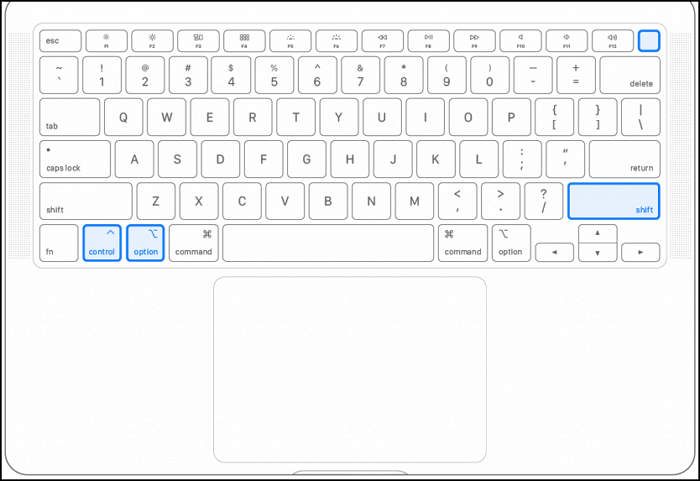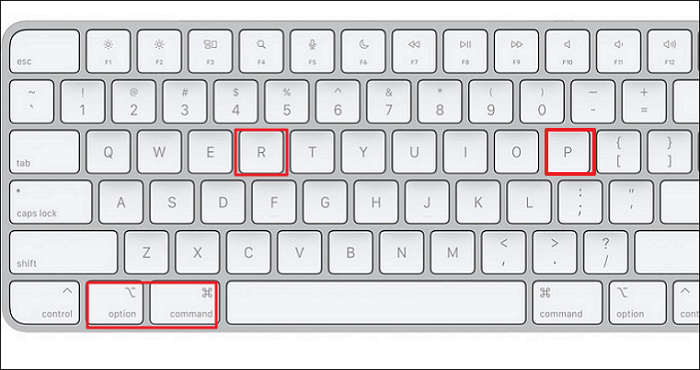To find the workable solutions to fix Mac runs slow after the macOS Ventura update, you can check the following chart:
| Workable Solutions | Step-by-step Troubleshooting |
|---|---|
| Fix 1. Quit Apps or Processes | Open "Utilities" in the "Applications" folder. Run "Activity-Monitor". Go to the "CPU" tab to see all...Full steps |
| Fix 2. Restart Your Mac | Click on the "Apple" button. Restart your system by clicking on the" Restart" button...Full steps |
| Fix 3. Check the Spotlight | Go to" System Preferences" and select "Siri & Spotlight". Under "Search Results" in the Spotlight...Full steps |
| Fix 4. Update the Application | Open that app's settings menu and then on "Software Update". Click on the "Check for...Full steps |
| Other Solutions | Enabling Motion effects and Transparency in your Mac can slow down your system...Full steps |
Why Is macOS Ventura Running Slow on Mac
With its fantastic productivity tools, the latest macOS upgrade - macOS Ventura, has revolutionized how people work. macOS Ventura is undeniably more effective and swifter than ever.
Any new upgrade will probably have bugs and errors that might slow your device down. macOS base system is no different, and here are some reasons why your Mac runs slow after updating to macOS Ventura:
- 📈After the upgrade to macOS Ventura, your Mac has less disk space and memory.
- 🚫Your Mac device has bugs or random errors that might lead you to downgrade macOS Ventura to Monterey.
- 📱The app causing the system to lag may need a different processor or graphics card.
- 🔖Even with the latest macOS Ventura update, older Macs perform slower because they lack the latest technology.
- 🖥️The desktop is overburdened with multiple files and apps.
So, now that we know the possible causes of your system's slow performance after installing the macOS Ventura update. Before jumping right into how to speed up macOS Ventura, you should know how to recover data lost because of updates or downgraded macOS versions.
Recover Lost Data Caused by Downgrading/Upgrading macOS 13
Your data can be deleted during the downgrading process of your macOS Ventura, and if that happens, you will lose it forever. And it is possible to lose data when the macOS Ventura upgrade failed. Thus, before reinstallation, we advise you to create a backup.
However, if you don't have a backup and want to recover your data, EaseUS Data Recovery Wizard for Mac is your best bet.
Here are some situations where data recovery software can help you out a tonne:
- ❌To recover lost data after macOS 13 Ventura installation failed.
- 🛠️To perform corrupted SD card recovery on Mac.
- 💽To extract data from a malfunctioning storage disk.
- 🗑️To recover Trash Mac and get back accidentally deleted files.
The app assists in resolving various challenging data loss situations like efficiently retrieving files from HDD, SSD, Fusion drives, Time Machine backup drives, SD cards, memory cards, USB drives, cameras, and emails. Follow the instructions given below and get back your lost data:
Step 1. Select the location
Select the disk where you lost data after updating to macOS Sonoma/Ventura/Monterey/Big Sur. Then, click "Search for lost files".

Step 2. Find lost data after the scan
EaseUS Data Recovery Wizard for Mac will immediately scan your selected disk volume and display the scanning results on the left pane. Use the file type and file path to find wanted data on Mac.

Step 3. Recover data after macOS update
Select the target files that were unknowingly lost during or after the update and click the "Recover" button to get them all back.

Fix Mac Runs Slow After macOS Ventura Update [8 Ways]
Downloading macOS Ventura on your Mac is a fascinating experience. But Isn't it annoying to notice that your Mac operates more slowly after an upgrade to macOS Ventura?
So, are you now planning to downgrade it to a lower version? Indeed, you can! However, remember that it is not the best or only fix available for the issue. Explore the eight fantastic ways below to speed up your Mac and enjoy your macOS Ventura update. Remember to share this passage to help more users fix Mac runs slow after the macOS Ventura update.
Fix 1. Quit Apps or Processes with Activity Monitor on macOS Ventura
Do you know that most programs on your computer run in the background and consume a significant amount of RAM and CPU? Your Mac might lag due to this, especially if it's an older Mac.
Activity monitoring is an adequate solution to prevent those apps or processes from running in the background and speed up your Mac. Let's see how:
Step 1. Open "Utilities" in the "Applications" folder.
Step 2. Run "Activity-Monitor".
Step 3. Go to the "CPU" tab to see all the background running apps.

Step 4. Select the app, then end its background operation to improve your Mac's performance.
Note: Spotlight also offers access to "Activity Monitor." Enter "Activity Monitor" by pressing Command and Space, then press the Return key. Check the amount of CPU/Memory an app uses, and if something seems out of the ordinary, kill the app to improve performance.
Fix 2. Restart Your Mac After macOS Ventura Updates
Restarting your computer is the fastest and most straightforward way to improve Mac performance after macOS Ventura updates. Restarting your computer can remove the random and pointless data clogging up your memory and impeding background processes.
Check the steps given below to restart your Mac and fix any underlying issues created by the macOS Ventura update:
Step 1. Click on the "Apple" button.
Step 2. Restart your system by clicking on the" Restart" button.

Note: You can also hard restart your system or force shut down Mac by holding the power button for a few seconds.
Fix 3. Check the Spotlight to See Whether Your Mac Is Reindexing
Spotlight allows you to search for files, applications, and much more throughout your entire Mac. However, periodically Spotlight may need to reindex your drive, especially after installing macOS Ventura, slowing down your system.
After the reindexing is complete, your Mac starts working fine. But if it takes too long, you can abort it by following the steps below.
Step 1. Go to" System Preferences" and select "Siri & Spotlight".

Step 2. Under "Search Results" in the Spotlight, you need to uncheck the checkbox next to each option.
This will stop the reindexing process and will fix your slow-running Mac.
Fix 4. Update the Application to the Latest Version on Mac
Sometimes the problem is not with your macOS Ventura but with the application you are using. Additionally, your Mac may lag because an app is incompatible with the newer version of the operating system. So update all your apps to take 100% advantage of macOS Ventura.
You will find the updates if you have downloaded the app from the App Store. But if you have downloaded it from a developer, you can follow the steps below:
Step 1. Open that app's settings menu and then on "Software Update".
Step 2. Click on the "Check for updates" option, and find the latest version of that app.

Step 3: Start updating your app. Now your system is fully updated with the latest version of macOS and the apps in it.
Note: The App Store allows you to update all your apps with just one click. Plus, it is verified by Apple for keeping your Mac safe.
Fix 5. Reduce Transparency and Motion on macOS Ventura
Enabling Motion effects and Transparency in your Mac can slow down your system too. These features take some system resources to function, which can be freed to further boost your Mac's performance.
We assure you that if you disable these, you will see significant improvement in your Mac performance. To do so, follow the instructions below.
Step 1. Open "System Preferences" and select "Accessibility."
Step 2. Click on "Display."

Step 3. Under the display, uncheck the "Reduce motion" and the "Reduce transparency" option. By doing this, you have successfully disabled motion and transparency effects. Try this method and see the difference in your Mac.
Fix 6. Free Up the Storage Space of Your Mac/MacBook and Speed Up macOS Ventura
When you update a mac, the new version of the Mac will always take more storage space than the previous one because of the new features added to it. And as a result, your system starts facing errors and lags, making the macOS Ventura slow.
So check your storage space and eliminate all the unnecessary files on your Mac. Or store essential data on any external drive to create free space for seamless macOS Ventura performance.
Follow the steps below to check your Mac's storage:
Step 1. Click on the "Apple Menu" and select "About this Mac."
Step 2. Select the "Storage" tab to see the storage information of your Mac.

If you find out that your storage space is running out, you can clear the junk files by following the steps.
Step 1. Click the "Manage" button.
Step 2. Select the "Optimized Storage" option on your Mac, and all your junk files will be deleted in one click.

This will help you clean your Mac of junk files that might make the overall system lag.
Fix 7. Remove Unnecessary Startup Applications to Speed Up macOS Ventura
After you launch your Mac, many apps automatically start running in the background. It will significantly slow down the startup process and your entire experience when those apps need to be updated.
We aim to remove those unnecessary apps that bog down our macOS Ventura's speed. So follow the process below:
Step 1. Open "System Preferences" and select "General."
Step 2. Select the "Login Items" option.

Step 3. In Login Items, turn off the apps you don't want to open at startup by clicking on the toggle switch against that option.
You have successfully removed the unnecessary startup load from your Mac, making your macOS Ventura fast.
Fix 8. Reset SMC/NVRAM/PRAM on Mac
Non-Volatile RAM or NVRAM is one of the most crucial parts of a Mac because all the new macs run on it. System Management Controller or SMC is responsible for maintaining the overall Mac's functioning.
So you have to be very careful while performing this fix to speed up your macOS Ventura. But assuming that nothing has worked for you, we have come up with this fix for you.
Resetting SMC/NVRAM/PRAM helps you clean any bug or error that might have been caused by the new Ventura update and clean your Mac for improving performance.
Here are the steps to reset SMC for iMac, Mac Pro, or Mac Mini:
Step 1. Power off your Mac and unplug the charging cord if attached.
Step 2. Plug the power cord back in after at least 15 to 20 seconds.
Step 3. Now turn on your Mac after 5 to 10 seconds.
For SMC reset in MacBook, MacBook Pro, or MacBook Air:
Step 1. Power off your Mac and unplug the charging cord if attached.
Step 2. Plug the power cord back in after 15 to 20 seconds.
Step 3. Hold the Shift+ Option+ Control and Power Key together for a minimum of 10 seconds, and once your MacBook turns on, release all keys.

To reset NVRAM and PRAM:
Step 1. Power off your MacBook.
Step 2. After 30 to 50 seconds, hold the Option+ Command+ P and R keys together until the Mac restarts.

Warning: Wrong steps can lead you to a big problem because your Mac can boot into recovery mode. So follow the instructions given carefully to avoid any issues.
We hope that the above-given fixes have helped you successfully improve the macOS Ventura's performance after an update. But if you still have issues with it, you can refer to our bonus tip and downgrade your macOS Ventura to an older version.
Bonus Tip: How to Downgrade macOS Ventura to an Older Version
Finally, after trying all the possible fixes, we have only one option: entirely reverting the macOS Ventura to the older version.
Reverting your OS can cause your data to be lost forever. However, we have a fix, so don't worry.EaseUS Data Recovery Wizard for Mac now has a new macOS Installer tool.
It can assist you in creating an automatic bootable installer for Ventura or older versions to downgrade macOS without effort.
Step 1. Select macOS installer
Launch EaseUS Data Recovery Wizard for Mac and click "macOS Installer" on the left side. In tab 1, unfold the macOS version list by clicking "Select macOS intaller". You can also select "Refresh" button after downloading the macOS installer from App Store.
You can download macOS installer to upgrade or downgrade macOS, and you can find all the available versions, no matter the latest or older versions. Morever, you can apply macOS installer to dual boot Mac and run two macOS together.

Step 2. Format the USB flash drive
Connect a USB flash drive (larger than 16 GB) to the Mac as your macOS boot drive. Choose the USB drive you prepared in tab 2 and click the "Erase and create" option in the pop-up window to format your USB flash drive. Then click the "Create macOS installer" button to start the creating.
- Important: This progress will delete all data on your USB flash drive, please back up the data before, or use EaseUS data recovery software to recover your data.

Step 3. Create the macOS installer boot drive
Click the "Finish" button after the macOS installer creating is finished. Follow the prompts on the interface to perform subsequent installation operations.

Summary
Hopefully, this article is a lifesaver for anyone who recently installed macOS Ventura but later discovered that their system has gotten extremely slow with an upgraded version. We have covered eight straightforward ways to speed up Mac OS Ventura. In addition, you can also follow the step-by-step tutorial for downgrading macOS Ventura.
With the aid of the effective data recovery tool EaseUS Data Recovery Wizard for Mac, you can also manage to keep your data from being lost permanently.
Mac Runs Slow After macOS Ventura Update FAQs
Even though we tried to cover everything related to Fix Mac Running Slow After macOS Ventura Update, if you still have questions, please see the FAQs listed below.
How do I downgrade macOS Ventura to Monterey on Mac?
Downgrading your macOS Ventura is risky in terms of data loss. Nevertheless, there is always a solution, so don't worry if you lose data because you can recover it using the EaseUS Data Recovery tool.
To downgrade macOS Ventura to Monterey:
- 1. Restart your Mac.
- 2. Hold the Shit+ Option+ Command+ R keys.
- 3. Enter the Password and hit "Continue".
- 4. Press "Next" and reinstall macOS.
Why is my Mac so slow all of a sudden in 2023?
There are many reasons why your Mac may be operating slowly, and here are some of the most common ones listed below:
- 1. Limited Disk Space and less memory available than the app you're using needs.
- 2. Your Mac might be outdated and can't handle the demanding resource requirements.
- 3. Too many background tasks clogging up your system
- 4. High-intensity visuals take up extra system memory and processing power
- 5. Outdated apps might cause errors
- 6. macOS might have some underlying bugs or system errors
What should I do if macOS Ventura is running slow on my MacBook Pro?
Here are a few simple and quick tips to improve the performance of macOS Ventura on your MacBook Pro:
- 1. End background processes and apps with Activity Monitor.
- 2. Disable startup programs.
- 3. Turn off the Stage Manager.
- 4. Install the most recent build of macOS.
- 5. Clear the clutter from your home screen.
- 6. Remove motion effects and Transparency.
How do I find out what is slowing down my Mac?
Many things might slow down your Mac. Try checking the following things to see what is slowing down your Mac:
- 1. Insufficient disk space.
- 2. Lots of background apps.
- 3. Use of demanding motion effects and Transparency.
- 4. High CPU and Memory usage.
- 5. Slow internet connection
- 6. Pending apps and system updates.
- 7. Junk files clog up the system.
Was This Page Helpful?
Jaden is one of the editors of EaseUS, who focuses on topics concerning PCs and Mac data recovery. Jaden is committed to enhancing professional IT knowledge and writing abilities. She is always keen on new and intelligent products.
Dany is an editor of EaseUS who lives and works in Chengdu, China. She focuses on writing articles about data recovery on Mac devices and PCs. She is devoted to improving her writing skills and enriching her professional knowledge. Dany also enjoys reading detective novels in her spare time.
Related Articles
-
FIX 'the device has either stopped responding or is disconnected' Error
![author icon]() Jean/2024-01-12
Jean/2024-01-12 -
System Service Exception Stop Code 0x0000003B in Windows 10 [10 Fixes]
![author icon]() Brithny/2024-11-25
Brithny/2024-11-25 -
macOS Monterey Update Not Found | How to Solve Monterey Update Issue
![author icon]() Dany/2024-10-25
Dany/2024-10-25 -
[Fixed] Ubuntu Format Disk: How to Format Disk on Ubuntu
![author icon]() Tracy King/2024-01-11
Tracy King/2024-01-11
EaseUS Data Recovery Services
EaseUS data recovery experts have uneaqualed expertise to repair disks/systems and salvage data from all devices like RAID, HDD, SSD, USB, etc.
